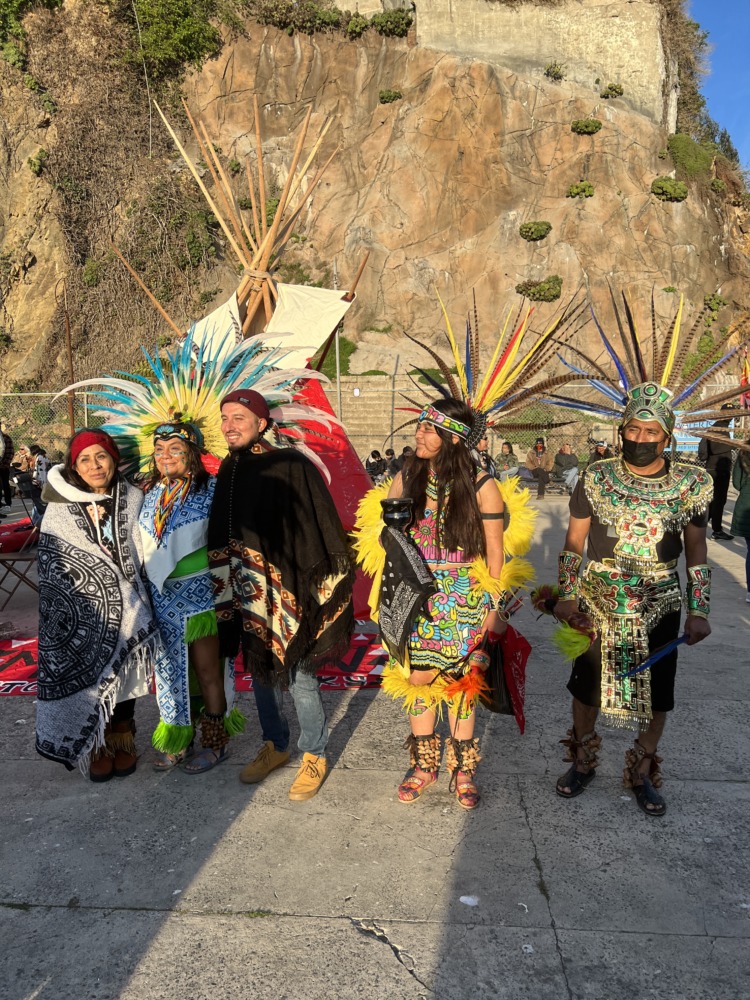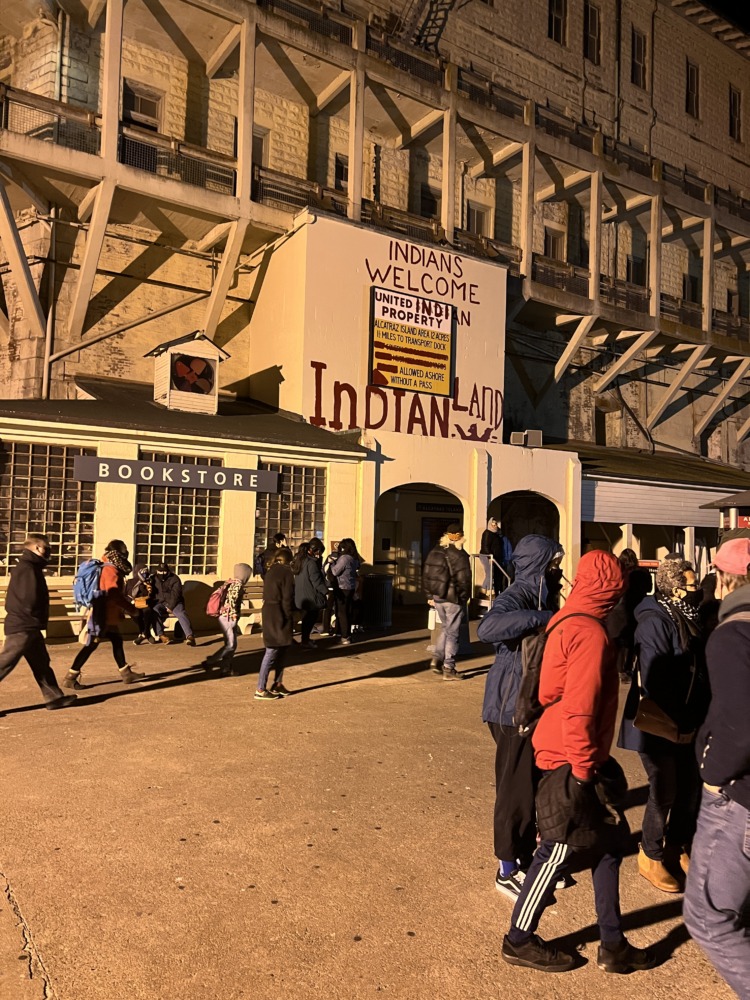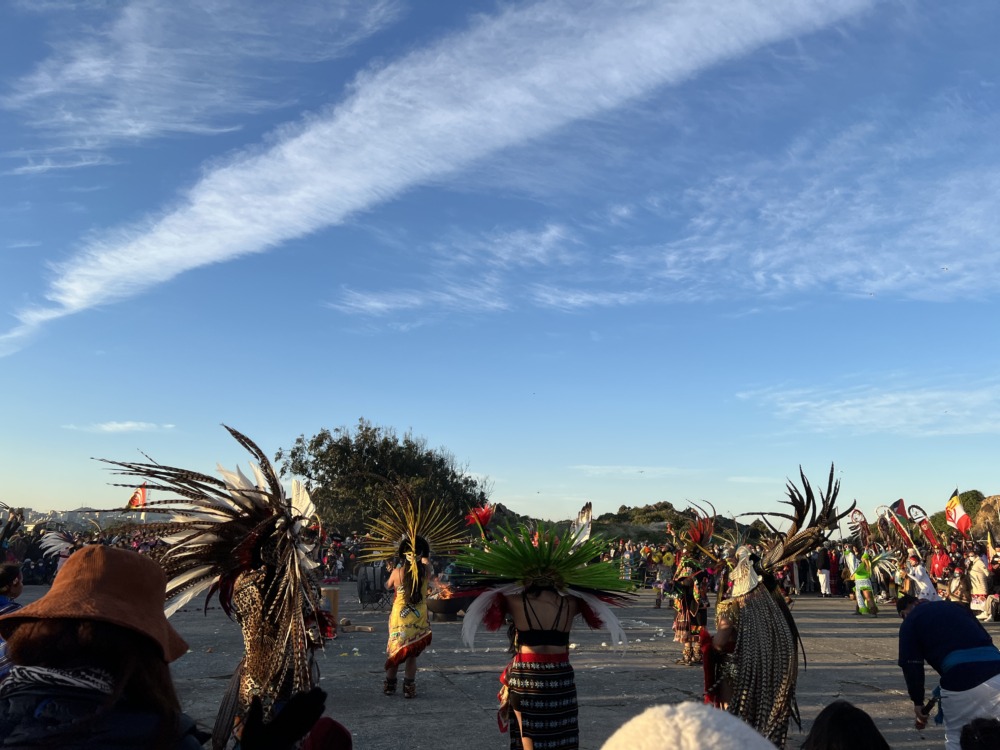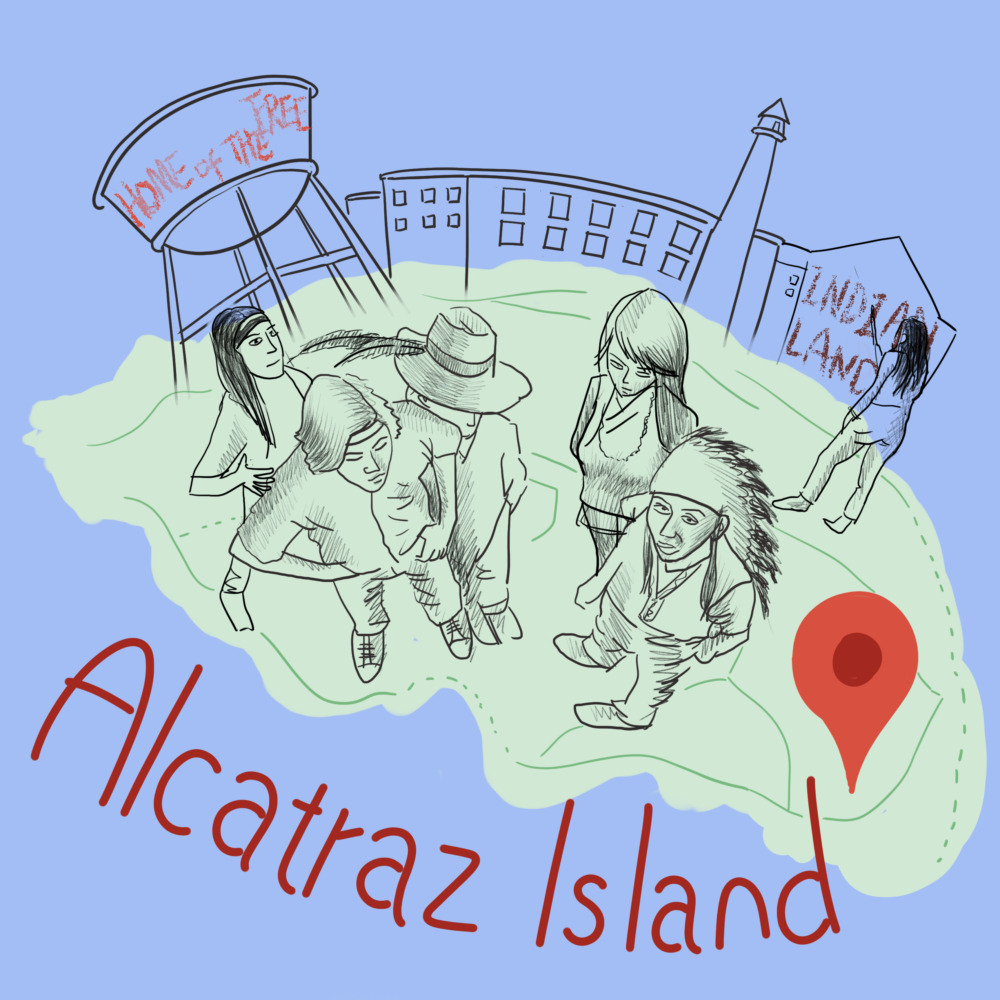Sunrise Gathering Continues Tradition of Native Activism on Alcatraz
By Julie Zigoris
julie.zigoris@gmail.com
The International Indian Treaty Council held its 43rd annual sunrise gathering ceremony on Alcatraz island on Thanksgiving, taking back a day that many in the Native community remember as a slaughter.
“Thanksgiving marks a genocide,” said Andrea Carmen (Yaqui), executive director of the International Indian Treaty Council (IITC). “The day after 700 Pequot were killed by British and Dutch mercenaries in 1673, the Massachusetts Bay Colony governor declared a day of Thanksgiving,” Carmen said.

island of the shuttered prison. Photo by Julie Zigoris/The Guardsman
Katarina Ruiz (Yaqui), who came from Monterey to attend the gathering, agreed. “It’s an honor to be around relatives on this day that celebrates a genocide,” Ruiz said on the early morning ferry ride to Alcatraz, when stars still salted the sky.
“The sunrise gatherings are our continued prayer — prayers for visibility and for a narrative shift about what Thanksgiving means,” said Morning Star Gali (Pit River Nation), the California tribal and community liaison for the IITC. “It’s why we do all this,” she said.
Morning Star Gali was named after the sunrise gathering, and she has been organizing the Alcatraz assembly since 2008. She started bringing her own children when they were very young, “on cradleboards and in baskets,” she said. When Gali started attending the Alcatraz ceremonies as a young girl it was a group of around 30, but the gatherings have evolved to number over 5,000.

refreshed over the years. Photo by Julie Zigoris/The Guardsman.
Vendors crowded the sidewalk along the Embarcadero in front of Pier 33 on Thanksgiving in the early morning, selling incense, sage, and beaded jewelry. People gathered from across the Bay Area and the country in the darkness, boarding ferries that ran from 4:15 a.m. -to 6:00 a.m. to Alcatraz.
The island has a deep connection to the Indigenous community. A group of 89 Native Americans, led by San Francisco State University student Richard Oakes (Akwesasne Mohawk), took over the island after the federal prison there had been abandoned. Native activists and their allies on the island eventually swelled to over 400, and occupied it for 19 months from 1969-71.
Pulling up to the island under the cover of darkness for this year’s ceremony, the original graffitied words of “Indians Welcome” and “Indian Land” painted in red were visible under spotlights. Passengers filed up the ramp to the parade ground, where a large circle had assembled around a fire, with chairs in the inner ring set up for elders. Flags for the American Indian Movement and Palestine flapped in the cold, clear night.
“In 1969 the occupiers were considered criminals and in 1971 the last group of 15 was forcibly removed from the island, but the graffiti on Alcatraz is now a featured element on the tour,” Carmen said. “It speaks to the evolution of perspective and the importance of having these events.”
The San Francisco Board of Supervisors issued a proclamation in 2009 recognizing the significance of the occupation of Alcatraz, and Interior Secretary Deb Haaland (Laguna Pueblo) attended an event on the island to honor the occupiers on Nov. 20, 2021.
At the time of the occupation Carmen was a freshman at the University of California, Santa Barbara and a member of a “small but mighty” Native American student association. Her group was invited to Alcatraz but she decided to organize support instead, collecting supplies for weekly deliveries to the island.
“It had the effect of radicalizing and politicizing our student group,” Carmen said of the occupation. “We became activists.”
Carmen draws a link between the occupation and the creation of the International Indian Treaty Council in 1983, of which she became executive director in 1992. It also was a contributing factor to the Declaration of Indigenous Rights, according to Carmen.

The Native connection to Alcatraz reaches beyond the occupation. The first prisoners on the island were Natives opposing missionaries, and Hopis were imprisoned there for resisting the forced removal of their children to boarding schools.
The sunrise gathering ceremony offers an opportunity for the Native community across the United States and beyond to gather. “It’s amazing how intertribal it is,” said Maggie Croft (White Earth Nation), a Bay Area writer who has attended the gathering five times in the past.
“We’re all so unique and yet there’s all these things in common,” Croft said. “We’re connected in meaningful ways — and really painful ways — but also in joyful, celebratory, amazing ways.”
Ruiz, who was attending her fourth sunrise gathering in 2021, also appreciated the opportunity to be immersed in an indigenous community. “We’re surrounded by white culture, so to be in this place where I’m around the music I like, the clothes I like, it’s a real honor,” she said.

The sunrise gathering on Alcatraz also embodies resilience within the Native community. “It’s important that we gather together to give thanks for our lives, the survival and resiliency of our cultures and the spirit of resistance passed down to us by our ancestors,” Carmen said.
“The indigenous cause doesn’t change, it just evolves. We want sovereignty of our land, water, and food,” Ruiz said.
An unbroken chain connected the original occupiers to this year’s gathering, with Elijah Oakes, Richard Oakes’ grandson, tending the fire in the center of the circle. Desiree Harp sang “Water so deep, water so wide” as seagulls cried overhead, human and avian voices joined together. Round Valley Pomo dancers performed as well as drummers and other musicians, with breaks in between for speakers.
Last year’s sunrise gathering was not open to the public given the pandemic, but the ceremony was broadcast on radio and the IITC’s Facebook page. Many were excited to return in person to the island this year.
“We lost way too many elders to the pandemic, but people are ready to come back out to offer thanks for our continued survival,” Carmen said. “Despite all the terrible things that have happened to us, we’ve survived.”
